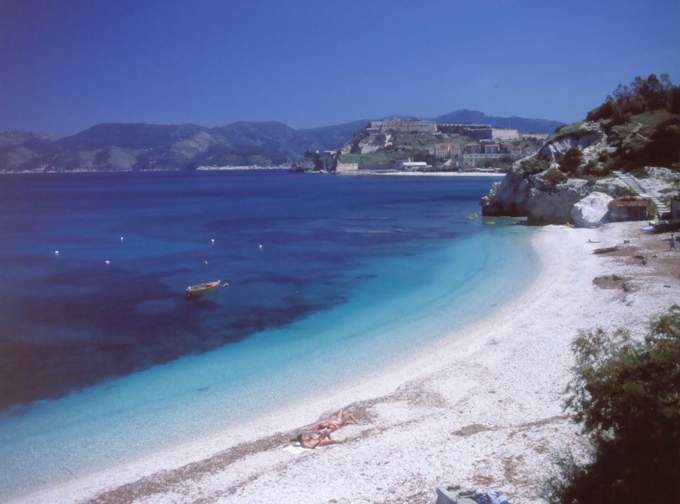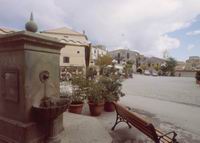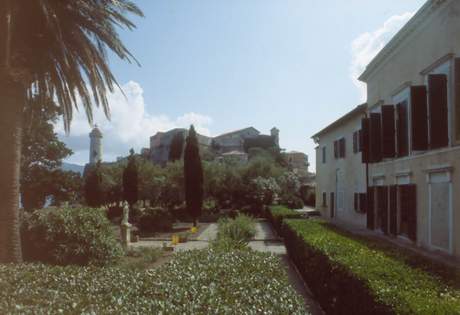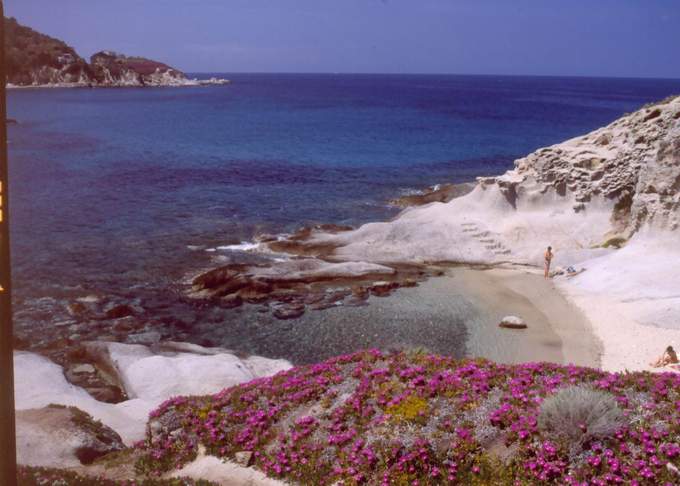|
For more than five millennia every civilitazion that has known this island, searching for wealth in its heart of stone and metal, has left its mark with skill and dedication, each contributing large and small treasures of art, devotion, style and culture.
Today, the island of Elba is marvelous garden that protects, without hiding, unexpected historicals features in every place you visit.
Although Neanderthal man was Elba's first inhabitant, the island's most important settlements date back to the 3rd millenium B.C., the Copper Age. Burial sites, complete with funeral paraphernalia, decorated earthenware, flint arrow-heads and various copper objects, especially those used in combat, remain from this period; just as valuable to archaeologists are the Bronze Age Storerooms, caches dug into the ground, where communities stored various objects, working tools and weapons. More distinctive and clearly visible on the landscape are the so-called Caprili, used since prehistoric times and found, in particular, on Monte Capanne. These are circular of elliptical constructions, up to 13 meters wide, with dry walls, covered with branches or, more rarely, with stone roofs consisting of concentric rings that become gradually narrower until they form a conical dome. Various menhirs can also be found on Monte Capanne: tall upright stones, some of which are arranged in mysterious formations.
The Etruscans lived on the island for many centuries from the 7th century b.C., onwards, but, due to their custom of building cities out of clay, which "dissolved" over the years, little trace remains of them today. However, the necropolies which can still be found testify to the existence of their lost villages: settlements in Portofferaio, Monte Castello near Procchio, Volterraio and Castiglione di San Martino. There was a fortress on Monte di Santa Lucia, rebuilt by the Pisans, and a temple, possibly dedicated to Tinia, on Monte Serra, near Rio.
The noble Roman patricians enjoyed discovering delightful places in which to build magnificent villas with sea views. Two of these villas face the sheltered bay of Portoferraio: Villa della Linguella, at the end of the Darsena, had its own private aqueduct and was decorated with beautiful mosaic floors. Villa delle Grotte, 1st century a.C., is very large and complex, with gardens descending on various levels down to the sea, where the villa had its own private landing stage.
Villa di Cavo, from the 1st-2nd century a.C., was built on the eastern side of the island on sloping terraces and had mosaic flooring. Part of the villa is contained within more recent constructions but is still possible to see the old water pipeline connected to a nearby hill. In addition to iron, the Romans also exploited the quarries offering valuable granite which was used to build the Pantheon and the Colosseum.
When Roman rule came to an end, the western part of the Mediterranean returned to its former insecurity, unless they were fortified, the cities along the coast were subjected to an increasing number of attacks. Even of the island of Elba, whole villages moved to the more mountainous areas which were more difficult to reach and lay siege to, and the number of inhabitants fell significantly. In the more isolated areas, small, even tiny communities of monks were created, including individual hermitages, called Romitori. These are often situated in places of great scenic beauty where it is possible to rediscover the peace and serenity experienced by these holy men. The oldest and most famous of these, the Romitorio di San Cerbone.
Between the 16th and 17th centuries, some of these places became sanctuaries dedicated to the worship of the Madonna, with very simple but distinctive structures. The medieval sanctuary of Madonna del Monte at Marciana, hidden within a cool chestnut wood, was realized between the 13th and 14th centuries, using large blocks of granite, and subsequently rebuilt in the 16th century.  Legend has it that the 16th century sanctuary of the Madonna delle Grazie at Capoliveri, with its Latin cross plan and scaly covered dome with oritental elements on the belfry spire, was inhabited by ancient hermits, the followers St. Mamiliano, who moved to the island of Montecristo after the 5th century. The sanctuary of the Madonna della Neve at Lacona, built in the 16th century on top of a previous Romanesque structure, was altered several times between the 17th and 20th centuries. The governor of Longone, José Pons y Léon, had the sanctuary of the Madonna del Monserrato, with its simple plastered dome, built in 1606 to evoke the sanctuary on the mountain of Montserrat Catalonia (at its inside is a Black Madonna; the small church is opened every year on 8th September and 8th April). The Sanctuary of Santa Caterina d'Alessandria, in Rio nell'Elba, which probably dates back to the 16th century is now center for European artists and has a botanical garden. Legend has it that the 16th century sanctuary of the Madonna delle Grazie at Capoliveri, with its Latin cross plan and scaly covered dome with oritental elements on the belfry spire, was inhabited by ancient hermits, the followers St. Mamiliano, who moved to the island of Montecristo after the 5th century. The sanctuary of the Madonna della Neve at Lacona, built in the 16th century on top of a previous Romanesque structure, was altered several times between the 17th and 20th centuries. The governor of Longone, José Pons y Léon, had the sanctuary of the Madonna del Monserrato, with its simple plastered dome, built in 1606 to evoke the sanctuary on the mountain of Montserrat Catalonia (at its inside is a Black Madonna; the small church is opened every year on 8th September and 8th April). The Sanctuary of Santa Caterina d'Alessandria, in Rio nell'Elba, which probably dates back to the 16th century is now center for European artists and has a botanical garden.
One of the greatest generals of alltime, after his defeat at Lepzig, Napoleon Bonaparte, was sent to rule the island of Elba. Between 1814 and 1815 all his efforts were directed towards this small new kingdom which he governed with anthusiasm: he studied local resources, reorganized agriculture, transport and trade, and even designed Elba's flag: white gold bees on a red stripe. It is easy to discover the many places occupied by Napoleon; the main one is the Villa dei Mulini in Portoferraio, between Forte Falcone and Falcone Stella, located in a prefect position for controlling both the sea and the town. This simple residence is the result of the union of two grand-ducal houses and includes the Salone dei Ricevimenti of Reception Hall, created by raising the ceiling, the Salone degli Ufficiali of Officers' Hall, a private study, the bedroom, and the Sala dei Valletti of Valtes' Room; the rooms have benn decorated and furnished in Empire Style. For the summer season, Napoleon chose a house in the contrusyde, the Villa di San Martino, not far from Portoferraio, with decorated rooms: the Sala Egizia or Egyprian Room, the Sala delle Colombe or Room of the Doves. A Doric style gallery was added to the Villa di San Martino in the mid 19th century, with a central pronaos, built by the Emperor's cousin, Prince Demidoff, to hold Napoleon's relics; over 200 books, including many essays suited to his smallkingdom, were donated to the people of Elba and are preserved at Villa dei Mulini.
There are two Napoleonic theatres: one in the Villa dei Mulini, and another, larger one, known as the Teatro dei Vigilanti, in the deconsacrated church of the Carmine in Portoferraio. Other Napoleonic sites on the island include the hermitage in the woods near the sanctuary of Madonna del Monte and, nearby, a curious rock known as "Napoleon's Chair", from where the Emperor is said to have admired the view of his Corsica.
Museums and collections constitute the most valuable legacy of every community: Elba's museums reflect the island's chequered history. In the Antiquarium, in Marciana, with objects recovered from ancient wrecks, and examples of granite working; The Museo della Linguella is located in Portoferraio, near the Roman villa and Medicean storehouses, and houses echibits recovered from the sea or from the excavations: objects from the Bronze Age, the Etruscan and Roman periods, as well as the important villas of Pianosa and Capraia. The Archaeological Museum in Rio nell'Elba includes exhibits from the Copper Age to the late Etruscan period, paying particular attention to the history of mining activities. The Pinacoteca Comunale or Municipal Picture Gallery in Portoferraio, most of which was donated by the Foresi family, houses important works of art from the 16th-19th centuries, by artists suc as Bergognone, Salvator Rosa, Guido Reni, Ciseri, Benvenuti, David and Michetti, as well as great 19th century landscape painters like Fattori, Nomellini, Cannicci and Signorini, who found the perfect light for the paintings on Elba. The Valle delle Ceramiche or Valley of Ceramics, near Portoferraio, is an open air museum dedicated to the artist Italo Bolano. Other interesting places of culture are the Museo delle Civiltà Contadina or Museum of Rural Culture in Marciana, the Centro Culturale De Laugier or De Laugier Cultural Center in Portoferraio and the large building in the Parco Minerario or Mineral Park and the Museo dei Minerali or Mineral Museum in Rio Marina.
 Art, story and nature are not the sole attraction of the island, other a sea of dream, paradise for bathers, navigators and sub and populated from a variegated fauna that besides includes dolphins and whales, at the Isola d'Elba is possible to taste very good enogastronomic speciality; the cultivation of vines has ancient origins:numerous dry-stone walls bear witness to the vineyard boundaries dating as far back as over 3000 years ago.and on the sea-beds there lie numerous ship wrecks loaded full with amphoras of wine. The Medici and the Lorraine families defendee the cultivation of vines and Napoleon ordered the planting of new vineyards. At leat 7 wines from Elba have been conferred with D.O.C. status (Denominazione di origine controllata), between that the Aleatico, the Ansonica and the Elban Raisin Wines Elba Bianco/Rosso (White/Red). Art, story and nature are not the sole attraction of the island, other a sea of dream, paradise for bathers, navigators and sub and populated from a variegated fauna that besides includes dolphins and whales, at the Isola d'Elba is possible to taste very good enogastronomic speciality; the cultivation of vines has ancient origins:numerous dry-stone walls bear witness to the vineyard boundaries dating as far back as over 3000 years ago.and on the sea-beds there lie numerous ship wrecks loaded full with amphoras of wine. The Medici and the Lorraine families defendee the cultivation of vines and Napoleon ordered the planting of new vineyards. At leat 7 wines from Elba have been conferred with D.O.C. status (Denominazione di origine controllata), between that the Aleatico, the Ansonica and the Elban Raisin Wines Elba Bianco/Rosso (White/Red).
The mountains, green and fresh, look like an oasis, where powerful trees grow and tall trunks and the inhabitants of the island have always taken advantage of this resource, planting chestnuts at least as far back as the 14th century. Its fruits, whether fresh, dried or ground into flour, have constituted the staple food for the mountain populations right up until just half a century ago. Chestnuts and wine nake a perfect pair to which we can also add mushrooms, the unforgettable fruit of the season. In autumn, in various areas of the island, hidden among the ilex woods, you can find more than types of mushrooms. Undoubtedly the most sought after and appreciated are the edible boletus and the ovule.
Cookery on Elba is based on fish and crustaceans, flavoured with typical Mediterranean spices. The fish caught off the island in the uncontaminated waters of the National Park of the Tuscan Archipelago is guaranteed to be fresh and unique. This is a goodness which weds environmental protection with healthy living. Between the most tasty dishes remember the Sburrita Riese, the Gurguglione and some of the typical sweets: Schiaccia Briaca(Tipsy bread), Pane Dolce del Marinaio (sailors' sweet bread), Cantuccini alle mandorle o all'anice (dry almond/aniseed biscuits), Schiacciunta (oily bread), Frangette (bowshpaed fried biscuits), with a glass of one of the local liqueurs that, ever since ancient times, are produced with alcohol and citrus fruits of the area of Sant'Andrea: the Limoncino (lemon liqueur) and the Arancino (orange liqueur) and besides the Crema di Limoncino (lemon cream), the Ciliegino (cherry liqueur) and the Liquore di Mortella.
Thanks to the Agency for the Touring of the Tuscan Archipelago for the texts and the images. |



 Munch: The Scream Within
Munch: The Scream Within In the garden
In the garden Perugia Travel Guide
Perugia Travel Guide



 Legend has it that the 16th century sanctuary of the
Legend has it that the 16th century sanctuary of the  Art, story and nature are not the sole attraction of the island, other a sea of dream, paradise for bathers, navigators and sub and populated from a variegated fauna that besides includes dolphins and whales, at the Isola d'Elba is possible to taste very good enogastronomic speciality; the cultivation of vines has ancient origins:numerous dry-stone walls bear witness to the vineyard boundaries dating as far back as over 3000 years ago.and on the sea-beds there lie numerous ship wrecks loaded full with amphoras of wine. The Medici and the Lorraine families defendee the cultivation of vines and Napoleon ordered the planting of new vineyards. At leat 7 wines from Elba have been conferred with D.O.C. status (Denominazione di origine controllata), between that the Aleatico, the Ansonica and the Elban Raisin Wines Elba Bianco/Rosso (White/Red).
Art, story and nature are not the sole attraction of the island, other a sea of dream, paradise for bathers, navigators and sub and populated from a variegated fauna that besides includes dolphins and whales, at the Isola d'Elba is possible to taste very good enogastronomic speciality; the cultivation of vines has ancient origins:numerous dry-stone walls bear witness to the vineyard boundaries dating as far back as over 3000 years ago.and on the sea-beds there lie numerous ship wrecks loaded full with amphoras of wine. The Medici and the Lorraine families defendee the cultivation of vines and Napoleon ordered the planting of new vineyards. At leat 7 wines from Elba have been conferred with D.O.C. status (Denominazione di origine controllata), between that the Aleatico, the Ansonica and the Elban Raisin Wines Elba Bianco/Rosso (White/Red).